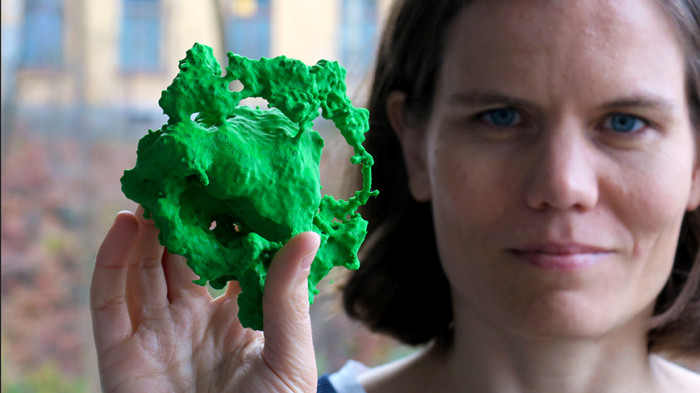Star’s self destruction is shown in 3D, revealing new details

Josefin Larsson displays a 3D printout of the remnants of supernova SNR 0540-69.3.
Credit: David Callahan
A 1,000-year-old supernova has been captured in 3D images that reveal yet unseen details of the elements that are ejected when a star explodes. Analysis of data from the Multi-Unit Spectroscopic Explorer (MUSE) and X-shooter at the European Southern Observatory’s (ESO) Very Large Telescope (VLT), offers new insights into how stars self-destruct.
The new study authored by Josefin Larsson, an astrophysicist at KTH Royal Institute of Technology in Stockholm, in collaboration with researchers at Stockholm University, the University of Warwick and at ESO, was published today in the Astrophysical Journal.
The supernova that the researchers studied, known as SNR 0540-69.3, is a familiar subject. For those observing the remnants of exploded stars, it’s one of the sky’s go-to supernovae, thanks to its relative proximity in the Large Magellanic Cloud, a small neighboring galaxy about 160,000 light years from Earth.
Yet SNR 0540-69.3 still has stories to tell. The new observations reveal the distribution of ejected material in unprecedented detail, leading to two new discoveries: a large ring of oxygen surrounding the supernova remnant’s innermost regions, and a mysterious blob of hydrogen unlike anything previously seen in other supernova remnants.
The study provides a three-dimensional map of the distribution of the ejected elements, in the forms of rings and clumps which carry significant information about the progenitor star and the explosion mechanism, she says. 3D mapping of these enables researchers to test theoretical models, adding to the growing body of evidence that such structures are omnipresent features of supernova ejecta.
“These ejecta have been traveling for a thousand years—it’s been a free expansion since the explosion,” Larsson says. “So it’s really telling us about the conditions at the time of the explosion.”
Larsson says that the results highlight the importance of asymmetries and mixing in supernova explosions. “What we see in the explosion is that all the elements get mixed. The original structure of the star is disrupted, and it’s clearly not symmetrical,” Larsson says.
Through fusion, stars evolve to form heavier elements at their core as nuclei combine into heavier nuclei. The evolution resembles an onion, with layers of gradually heavier elements forming inward. When a star explodes, the innermost core collapses to form a neutron star — but the outer layers of sulfur, argon, oxygen and hydrogen among other elements, are mixed and ejected in what Larsson describes as an “asymmetric distribution of rings and clumps.”
Rings of ejecta have been observed in a small number of other nearby supernova remnants, but the particular case of SNR 0540 adds valuable new information by revealing small-scale rings in the very innermost regions in a way not seen in those other cases.
Larsson says she is intrigued by the origin of the hydrogen blob. “Is it part of the material ejected in the explosion?” she asks, “Or, maybe it was blown off from the outer layers of a binary companion star.”
The explosions of supernovae are critical to understanding the contents of the universe, she says. “They spread elements formed in the star and in the explosion itself. Without stars and supernovae, we would essentially only have hydrogen and helium in the universe.”
This research was supported by the Knut and Alice Wallenberg Foundation, the Swedish Research Council and a UK Research and Innovation Fellowship (MR/T020784/1).
Wissenschaftliche Ansprechpartner:
Press Contact
David Callahan
Epost:
callahan@kth.se
Weitere Informationen:
https://resources.mynewsdesk.com/image/upload/t_next_gen_article_large_767/hwmck…
https://www.expertsvar.se/en/pressmeddelanden/stars-self-destruction-is-shown-in-3d-revealing-new-details/
Media Contact
All latest news from the category: Physics and Astronomy
This area deals with the fundamental laws and building blocks of nature and how they interact, the properties and the behavior of matter, and research into space and time and their structures.
innovations-report provides in-depth reports and articles on subjects such as astrophysics, laser technologies, nuclear, quantum, particle and solid-state physics, nanotechnologies, planetary research and findings (Mars, Venus) and developments related to the Hubble Telescope.
Newest articles

Innovative 3D printed scaffolds offer new hope for bone healing
Researchers at the Institute for Bioengineering of Catalonia have developed novel 3D printed PLA-CaP scaffolds that promote blood vessel formation, ensuring better healing and regeneration of bone tissue. Bone is…

The surprising role of gut infection in Alzheimer’s disease
ASU- and Banner Alzheimer’s Institute-led study implicates link between a common virus and the disease, which travels from the gut to the brain and may be a target for antiviral…

Molecular gardening: New enzymes discovered for protein modification pruning
How deubiquitinases USP53 and USP54 cleave long polyubiquitin chains and how the former is linked to liver disease in children. Deubiquitinases (DUBs) are enzymes used by cells to trim protein…


